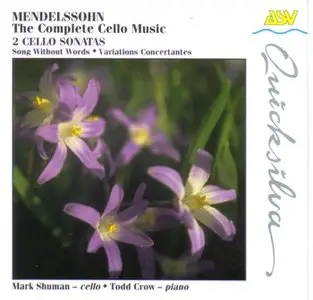Felix Mendelssohn - The Complete Cello Music
MP3 at 320 kbps CBR. | 145.89 Mb | 61:42 minutes | Covers.
classical, romantic | ASV Records, Recorded at Skinner Hall, Vassar College, New York,in June 1987
MP3 at 320 kbps CBR. | 145.89 Mb | 61:42 minutes | Covers.
classical, romantic | ASV Records, Recorded at Skinner Hall, Vassar College, New York,in June 1987
Mendelssohn was briefly between jobs when he wrote the second of his two cello sonatas; he was making the transition from handling musical matters for the King of Prussia to assuming the directorship of the new Leipzig Conservatory. The attendant stress of this period is hardly reflected in this sonata, which the composer wrote for his brother Paul, a cellist. The first movement, Allegro assai vivace, begins with a surging, confident melody for the cello, underpinned by a pressing piano accompaniment. The keyboard then presents its own statement of the theme, the cello now relegated to the background. The piano remains dominant during the introduction of the more lyrical but still impulsive second subject, but the cello eventually gets its turn at an extension of the tune. Unwary listeners might gather that Mendelssohn is here launching a third subject, but the cello is clearly playing the flowing outline of the melody the piano has just broached. Indeed, the instruments will be treated as equals throughout most of this sonata, and often each is allowed a virtuoso flourish. Mendelssohn develops his themes sequentially and neatly, with an almost circumspect ardor that never subordinates one instrument to the other. While Felix Mendelssohn's devotion to his sister Fanny is well known, the composer's relationship with his youngest sibling, Paul, is rather more obscure. After all, while elder brother and sister both secured their positions in music history as gifted composers and performers, Paul maintained his musicianship only as a hobby, and pursued banking as a vocation. He was deeply devoted to Felix, however, and, after the composer's death, looked after his brother's family and worked to preserve his musical legacy. Felix showed his devotion in kind, as well, dedicating to his brother a pair of works for Paul's chosen instrument, the cello: the Sonata in B flat, Op. 45 (1838), and the work to be considered here, the Variations concertantes for cello and piano in D major, Op. 17. Mendelssohn composed the Variations concertantes in early 1829, and saw the work's premiere in the summer of that year. If one is meant to surmise Paul's musical personality and aptitude on the cello through Felix's piece, one must assume he was a musician of respectable technical skill and even greater wit and aplomb. Throughout the concertante theme and the eight subsequent variations, the composer conveys a sense of elegant lyricism combined with clever textural and thematic interplay between the cello and piano. The theme itself presents an arching line, leaping upward and then falling in stepwise fashion, that serves as the basis for a series of characteristically clear-cut phrases. As is his custom, Mendelssohn avoids structural tension or formal deviation in favor of more subtle invention, as in the transfer of attention between cello and piano. The two share the melodic spotlight in the opening theme, then, as the cello assumes the lead in the first variation, the piano provides an accompaniment that gradually shifts from nimble staccato arpeggios to more lush textures. The piano's virtuosic prominence in the second variation sets up the cello's sudden pyrotechnics in the third; halfway through, though, the cello's aerobic agility suddenly turns isometric, settling on a slyly extended trill underneath a gentle piano passage. The frenetic keyboard work of the fourth variation contrasts the quirky regality of the fifth, with its dotted rhythms and pizzicato cello. The sixth variation's gentle inertia leads to the chromatic, minor-mode turbulence of the seventh, which in turn renders all the more dramatic the final variation's extended thematic closure and understated ending.
Mark Shuman: cello
Todd Crow: piano
1. Sonata No.2 - First Movement. Allegro assai vivace (7:29)
2. Sonata No.2 - second Movement. Allegretto scherzando (4:59)
3. Sonata No.2 - Third Movement. Adagio (5:43)
4. Sonata No.2 - Fourth Movement. Molto allegro e vivace (6:31)
5. Song Without Words Op.109 (4:25)
6. Sonata No.1 - First Movement. Allegro Vivace (11:50)
7. Sonata No.1 - Second Movement. Andante (5:42)
8. Sonata No.1 - Third Movement. Allegro assai (6:09)
9. Variations Concertantes Op.17 (8:54)
MP3 (RS) Part1 –- MP3 (RS) Part2
all my uploads here



